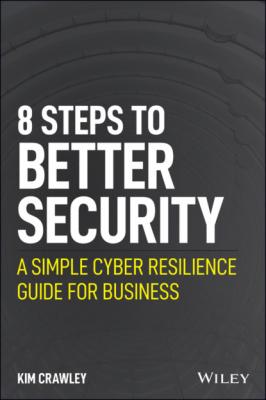8 Steps to Better Security. Kim Crawley
Читать онлайн.| Название | 8 Steps to Better Security |
|---|---|
| Автор произведения | Kim Crawley |
| Жанр | Зарубежная компьютерная литература |
| Серия | |
| Издательство | Зарубежная компьютерная литература |
| Год выпуска | 0 |
| isbn | 9781119811244 |
170 162
171 163
172 164
173 165
174 166
175 167
176 168
177 169
178 170
179 171
180 172
181 173
182 174
183 175
184 176
185 177
186 178
187 179
188 180
189 181
190 182
191 183
192 184
193 185
194 186
195 187
196 188
197 189
198 190
199 191
200 192
201 193
202 194
203 195
204 196
205 197
206 198
207 199
208 200
209 201
210 202
211 203
212 204
213 ii
214 iii
215 iv
216 v
217 205
8 Steps to Better Security
A Simple Cyber Resilience Guide for Business
Kim Crawley
Foreword
I first met Kim Crawley in person in October 2019, in Toronto at SecTor, Canada's version of DEFCON. We'd been acquainted for a long time via Twitter, and she was the one who originally turned me onto SecTor and inspired me to submit a talk, citing the merits of her hometown and the conference. She was right about both. In between the superb sessions there, amidst the fantastic energy of that conference and the international vibe of the city, we walked around and talked about information security, cyber resilience, and neurodiversity, topics woven deeply into the fabric of both our lives. Over lunch one afternoon, our conversation came around to how our industry can do a better job of helping small and midsize organizations better prepare for strategic response to cybercrime. We agreed that by helping smaller and more vulnerable organizations, the larger organizations and the collective industry as a whole would also benefit. We compared notes on tactics and strategies that don't have to cost a lot of time or money.
Shortly after our time and discussions at SecTor, Covid-19 hit. Kim didn't slow down. She founded DisInfoSec, a pop-up infosec conference showcasing infosec professionals who identify as neurodivergent (including ADD, AHDH, autism, Asperger's, dyslexia, and more). Inspired by Lesley Carhart's PancakesCon and other events, DisInfoSec was a first-of-its-kind event and took place on July 11, 2020. The con included a lot of great talks and raised funds for the Autistic Self Advocacy Network, the Autistic Women and Nonbinary Network, and the Council of Canadians with Disabilities. Kim's commitment to improving inclusion and nudging the world to a better place is showcased in her actions, and this new book is merely an extension of her productive mindset.
If you're new to Kim's work, her past and present articles on infosec and cyber for AT&T Cybersecurity, Cylance, and others are some of the most accessible to read, especially for anyone who is new to those topics. Kim writes with spirit and an intimate awareness of the diverse audiences who may be reading, which makes her style a stand-out. Her new book is no exception: 8 Steps to Better Security: A Simple Cyber Resilience Guide for Business is an easy read for first-timers, seasoned veterans, and anyone else keen to learn more about infosec and cyber resilience using practical, quick-win steps you can take right away to better prepare your organization for a strategic response to unplanned events that would otherwise compromise your productivity, reputation, and bottom line. That's real peace of mind, and I don't know about you, but these days I'll take all of that I can get. Enjoy the book!
Chad Calease
Chief Information Security Officer
https://resilience.sh
Introduction
Pandora's box has been opened. Businesses in all industries run on computer data, and now there's no turning back.
When I was little, offices were still full of filing cabinets. Each customer, patient, client, vendor, and supplier had their own labeled manila folder in one of those cabinets. In fact, many offices have kept their filing cabinets well into the 21st century. Spilling your coffee on a few forms could damage lucrative business data. Unauthorized data access happened if someone found the secretary's physical key and unlocked cabinets they weren't entitled to. Some cabinets were designed to be fire resistant. But backing up all that data to a second location for the sake of business continuity in a disaster is always a good idea, one that was often not conducted because a clerk would have to put each page through the photo copier one by one, ever so tediously.
Now businesses keep their lucrative data on computers, whether that business is Smith's Convenience on the street corner or a multibillion-dollar military contractor. Some of these businesses still have filing cabinets, but they're working hard to digitize as much as possible.
The computer data that flows through businesses in all industries isn't just sensitive data on customers. It isn't all precious financial data, either. Some of it is security patches for our operating systems, applications, and firmware. Some of it is the email your employees are sending and receiving, whether on a company-owned PC or on their phone wherever they are. Some of it even keeps devices in the office running—your smart thermostats and your internet-connected heart monitors.
Keeping all the data that flows through your business secure is absolutely vital. Otherwise, a cybercriminal could steal your trade secrets or your clients' credit card data. Or they could perform a distributed denial-of-service attack on your production systems. Or they could infect your whole network with ransomware, both on the premises and on the cloud. Your company can be liable for any sensitive data that's stolen, especially if it results in your customers and vendors being harmed. And if your production systems face even a couple of hours of downtime, your business could lose millions in productivity. Chances are there are data privacy
